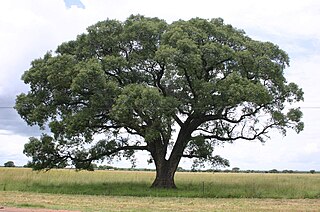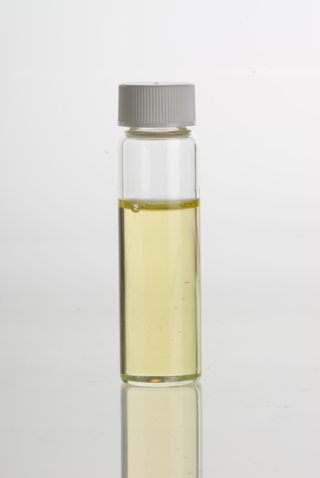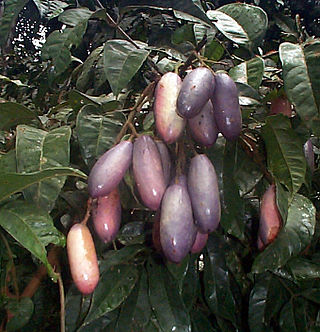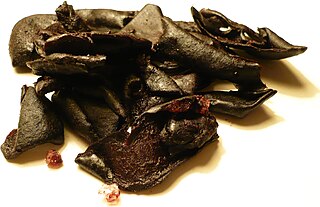
The almond is a species of tree native to Iran and surrounding countries, including the Levant. The almond is also the name of the edible and widely cultivated seed of this tree. Within the genus Prunus, it is classified with the peach in the subgenus Amygdalus, distinguished from the other subgenera by corrugations on the shell (endocarp) surrounding the seed.

The sunflower seed is the seed of the sunflower. There are three types of commonly used sunflower seeds: linoleic, high oleic, and sunflower oil seeds. Each variety has its own unique levels of monounsaturated, saturated, and polyunsaturated fats. The information in this article refers mainly to the linoleic variety.

Vitellaria paradoxa, commonly known as shea tree, shi tree, or vitellaria, is a tree of the family Sapotaceae. It is the only species in the genus Vitellaria, and is indigenous to Africa.

Sclerocarya birrea, commonly known as the marula, is a medium-sized deciduous fruit-bearing tree, indigenous to the miombo woodlands of Southern Africa, the Sudano-Sahelian range of West Africa, the savanna woodlands of East Africa and Madagascar.

Sesame oil is an edible vegetable oil derived from sesame seeds. The oil is one of the earliest-known crop-based oils. Worldwide mass modern production is limited due to the inefficient manual harvesting process required to extract the oil. Oil made from raw seeds, which may or may not be cold-pressed, is used as a cooking oil. Oil made from toasted seeds is used for its distinctive nutty aroma and taste, although it may be unsuitable for frying, which makes it taste burnt and bitter.

Shea butter is a fat extracted from the nut of the African shea tree. It is ivory in color when raw and commonly dyed yellow with borututu root or palm oil. It is widely used in cosmetics as a moisturizer, salve or lotion. Shea butter is edible and is used in food preparation in some African countries. Occasionally, shea butter is mixed with other oils as a substitute for cocoa butter, although the taste is noticeably different.

Bactris gasipaes is a species of palm native to the tropical forests of Central and South America. It is well spread in these regions, where it is often cultivated by smallholders in agroforestry systems or more rarely, in monoculture. Common names include peach palm in English, among others used in South American countries. It is a long-lived perennial plant that is productive for 50 to 75 years on average. Its population has an important genetic diversity, leading to numerous fruits, colors, and qualities. The fruits are edible and nutritious but need to be cooked for 30 minutes to five hours. They also benefit many animals in the wild. Peach-palms are also cultivated for the heart of palm, and the trunk can make valuable timber.

Ricinodendron is a plant genus in the family Euphorbiaceae first described as a genus in 1864. It includes only one known species, Ricinodendron heudelotii, native to tropical Africa from Senegal + Liberia east to Sudan and Tanzania and south to Mozambique and Angola. It produces an economically important oilseed. The tree is known as munguella (Angola), njangsa (Cameroon), bofeko (Zaire), wama (Ghana), okhuen (Nigeria), kishongo (Uganda), akpi, djansang, essang, ezezang and njasang. Two varieties of the tree species are recognized R. heudelotii var. heudelotii in Ghana and R. heudelotii var. africanum in Nigeria and westwards.

Canarium ovatum, the pili, is a species of tropical tree belonging to the genus Canarium. It is one of approximately 600 species in the family Burseraceae. C. ovatum are native to the Philippines. They are commercially cultivated in the Philippines for their edible nuts and is believed to be indigenous to that country. The fruit and tree are often vulgarized with the umbrella term of "Java almond" which mixes multiple species of the same genus, Canarium.

Irvingia gabonensis is a species of African trees in the genus Irvingia, sometimes known by the common names wild mango, African mango, or bush mango. They bear edible mango-like fruits, and are especially valued for their fat- and protein-rich nuts.

Eugenia stipitata is a fruit tree native to the Amazon Rainforest in Brazil, Colombia and Ecuador.

Dacryodes edulis is a fruit tree in the Burseraceae family native to Africa. Its various regional names include safou, plum (Cameroon), atanga, ube, elumi (Nigeria), African pear, bush pear, African plum, nsafu, bush butter tree, or butterfruit.

Allanblackia is a genus of flowering plant in the family Clusiaceae. Molecular phylogenetic analyses indicate that is it nested in the dioecious Garcinia. The genus name commemorates Allan Black.

Gnetum africanum is a vine gymnosperm species found natively throughout tropical Africa. Though bearing leaves, the genus Gnetum are gymnosperms, related to pine and other conifers.

Treculia africana is a tree species in the genus Treculia which can be used as a food plant and for various other traditional uses. The fruits are hard and fibrous, can be the size of a volleyball and weight up to 8.5 kg (19 lb). Chimpanzees have been observed to use tools to break the fruits into small pieces that they can eat. The fruits contain polyphenols.

Vitellaria paradoxa is extremely important in Burkina Faso. Termed "women's gold" by Burkinabé villagers, the nuts of shea tree can be collected and processed by crushing and grinding to yield shea butter, which is widely used in soap and in cosmetics as a moisturizer, salve, or lotion. Shea butter is also edible and may be used in food preparation; it is sometimes used in the manufacture of chocolate. The bark of the tree is also used as an ingredient in traditional medicines and the shell of nut is said to be able to repel mosquitoes and is also said to protect existing trees.

Detarium microcarpum, commonly known as sweet detar, sweet dattock or tallow tree, is an underutilized species of tree legume that grows naturally in the drier regions of West and Central Africa. It has a wide range of uses due to its medicinal properties, edible fruit and hardwood, which is used as fuel. This makes it valuable and appreciated by local communities, but further research and effort are needed for its domestication.

Kokum oil is a seed oil derived from the seeds of the kokum tree. Kokum oil is edible and can also be used for things other than cooking.

Phulwara oil is extracted from seeds of Phulwara tree. Phulwara Trees are also known locally as Chiuri Trees, Kaeleb Trees, or Butter Nut Trees. Refined Phulwara Oil is marketed as Phulwara Ghee.

Canarium indicum, known as galip nut, is a mainly dioecious tree native in eastern Melanesia. It is usually found in rainforests, secondary forests, old garden areas, around villages and settlements. It is also used as a shade tree, as a windbreak and in agroforestry. Canarium is important in the world food system as it can be used as a food and timber source, in traditional medicine, intercropping and agroforestry.


















